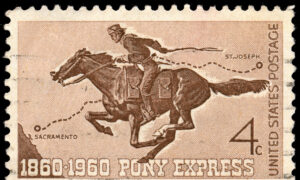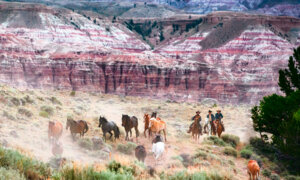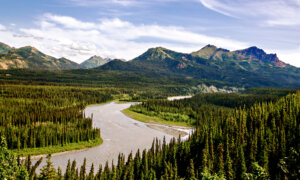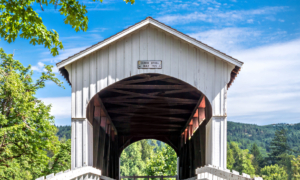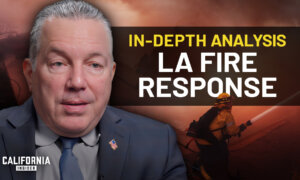The Grand Canyon is one of the most timeless places on earth. The spectacle of the sunrise over the mile-deep, 18-mile-wide chasm is as mesmerizing as watching ocean waves. But just as you can’t grasp the size of the swells without swimming, you can’t comprehend the depth of the canyon without descending. The best way to see it is looking up at the massive walls from a raft while journeying down the Colorado River.

<span style="font-weight: 400;">River guides Bill Frothingham (L), Shelby Wolfe, Ben Bressler, and Joe Clark sit on the pontoons of the 35-foot J-Rigs. </span> (Maria Coulson)
Millions travel to stand on the edge of the Grand Canyon, gaze across the expanse, and peer into the abyss. “It’s more than the wide-angle shot of the canyon from above,” landscape photographer Willie Holdman pointed out. “It’s the graphic nature of rock patterns adorning the walls. It’s the trickle of water dripping from the moss in a deep side canyon with golden reflected light. It’s the scarlet pincushion buds on a cactus, or perhaps the turquoise water flowing over travertine ledges with red monkey flowers in the many tributaries.”
With 5 million people visiting Grand Canyon National Park in Arizona each year, it’s the most popular of the seven natural wonders of the world. But only 25,000—one half of 1 percent—take to the river. The vast majority of those go with commercial outfitters, such as the preeminent Western River Expeditions (WesternRiver.com/Grand-Canyon-Rafting), which has operated rafts since 1961. “The access a raft provides to the hidden gems in the canyon cannot be understated,” the 54-year-old Holdman contends. “You can see in seven days what it would take months, if not years, to see on foot hiking into it.”
Our weeklong, 188-mile river adventure ran the gamut from peaceful moments floating on calm water to the adrenaline rush of turbulent rapids; hikes over sunbaked, barren terrain to frolics in pristine pools created by plunging waterfalls; surreal sunsets and starlit nights to a whipping windstorm and bleary-eyed sunrise.

A claret cup hedgehog cactus blooms near Deer Creek Falls. (Willie Holdman)
Centrum Silver Safety
On the first day, my wife, Maria, and I mingled with two dozen other passengers at the starting point, Lee’s Ferry, about 15 miles downriver from Page, Arizona. A disparate group from across the United States, ranging in age from early 30s to mid-70s, we stood staring at the twin 37-foot rafts and assortment of large, clearly numbered, waterproof bags—containing our cameras and clothing—that were strung out across the sandy beach. Gear was strapped onto the crafts in a tight packing system: giant coolers of food and water; folding tables and chairs; cans of fuel, pots and pans; a tidy toilet system; plus beer and soft drinks.
Designed by Western River Expeditions’ founder, the 35-horsepower J-rigs are stable, and ride and flex over the waves. The half dozen wives on our 12-passenger craft christened their retired husbands the Centrum Silver Six. We frequently sat at the front, straddling the rubber pontoons, where the river’s powerful current time and again drenched us on the so-called “thrill” seats.
Centrum Silver Jim Wisner, 65, a member of the U.S. Coast Guard Auxiliary in Galveston, Texas, said, “I am very, very impressed by Western’s focus on safety. This is clear from the organization of the trip, the well-trained and experienced crews, and the attention to detail in planning for every contingency. Such preparation comes from being a very seasoned and professional operator on the river.”

Havasu Creek’s turquoise waters cascade below red canyon walls. (Maria Coulson)
Guide Quartet
Trip leader Ben Bressler, 46; veteran boatman Joe Clark, 39; and swampers Bill Frothingham, 32, and Shelby Wolfe, 24, who all live in nearby Southern Utah, maintain Western River Expeditions as their second home. “The people I work with are my family,” Clark, a 19-year river runner, said. “It’s a small company; we all know each other, we spend time away from work with each other, we support each other, we love each other, and we share a common passion for the river life.”
Tennesseans Tyler and Margaret Beard, who wanted to celebrate their 10th wedding anniversary “doing something adventurous outside of our comfort zone,” applauded the company’s front office for being “unbelievably responsive” in answering their many questions. Beard described the four river guides as “fantastic!” They were, in her words, “patient and amusing, and super knowledgeable about the geology of the canyon and the history of the river.”
“Our guides have an altruistic orientation to the work they do,” said Cindy Sibley, from Santa Fe, New Mexico. “It’s more than a job and pay to them. It has to do with their connection with nature, with a fragile environment, and with their love of connecting with people.”

Boatman Joe Clark skillfully steers our raft through Granite Rapid. (Willie Holdman)
Harmony and Camaraderie
They settled us into a rhythm with the river and created a feeling of harmony and camaraderie. Everyone helped load the boats each morning and unload them each evening. When the nights grew warmer, we slept on cots immersed in the majesty of the Milky Way. “Sleeping underneath a canvas of stars framed with deep canyon walls makes you a companion with the spirit of the canyon,” Holdman said.
One night, we camped across the river from a statuesque waterfall; another, within foreboding earshot of the next raging rapid; and the last, hearing the sound of singing and the strumming of Clark’s acoustic guitar. Each morning, Bressler’s whacky trumpet call at 5:30 signaled coffee was ready. A half hour later, we were served hearty breakfast variations of fried or scrambled eggs, bacon or sausage, fluffy pancakes or thick French toast, and cereal and fresh fruit.
It’s the ultimate 24/7 experience. Rafting or hiking much of the day, you’re eating, bathing, and sleeping together. While there are ample chances for meditative moments, it’s a communal endeavor. “Once you start the Grand Canyon river trip, you’re committed to it,” Bressler said during his 198th trip over 23 years. “There’s no getting out; you’ve got to see it through.”
The early spring excursion, amid ephemeral green growth resplendent with blazing wildflowers and blooming Yuccas, was Western’s Willie Holdman’s annual “Grand Canyon River Run” photography workshop (WillieHoldman.com). The superb shooter led two to three hikes into side canyons each day. When they demanded rock scrambling—which led me to nickname him “Willie Goat”—the ever-vigilant Wolfe and Frothingham were there to extend a steadying hand. On a memorable hike headed up Havasu Creek, we took pictures standing in the middle of clear, sandy-bottom, aquamarine pools reminiscent of a lush desert oasis.

Canyon walls reflected in glassy water. (Maria Coulson)
Raging Rapids
When we first shoved off, the Colorado River was a gentle float punctuated by infrequent riffles and minor rapids. About 60 miles downstream, at the confluence with the Little Colorado, the Grand Canyon’s walls widened to reveal a broad breadth of sky. Then, just as suddenly as they opened, they narrowed. The rapids grew in size and intensity, dancing on the horizon, tossing waves into the air like confetti.
Our raft careened through the gorge in a rollicking, roller coaster ride that evoked screams and laughter with the heart-racing thrill of it. One moment, we were plunging into surging and collapsing Volkswagen Beetle-sized waves; the next, we were awash as the raft shot up and over curling crests. When the sun was hidden by dark clouds or by the shadow of sheer cliffs, we shivered between the white-knuckled, bouncing bouts. These cold-water dousings are refreshing when summer temperatures soar to 115 degrees F, and the river is teeming with guided outfits. In mid-April, the river and shivers belonged to us.
We were jubilant after running storied Lava Falls rapid, which bucked like a blue-ribbon brahman bull and resounded like a freight train colliding with a jetliner. “I was terrified of the rapids, really terrified,” Sibley admitted. “But I never once felt unsafe. The crew made me feel cared for.” The 62-year-old said she believes that at the end of our lives, it’s not so much the things we did that we regret, as the things we did not do. “I am so glad I came on the trip and conquered that fear.”
Tranquil Interludes
The white-water ferocity plays against stretches of glassy serenity. Reflective silence is broken only by the sounds of wind and wildlife. We heard a red-tailed hawk’s plaintive cry, watched a falcon’s acrobatic flight in pursuit of prey, craned our necks to follow soaring California condors with 9-foot wingspans, and observed sure-footed bighorn sheep scale steep cliffs.
During these tranquil interludes, Clark might recite inspirational or jocular poetry from memory. Bressler might read passages from his dog-eared and water-stained paperbacks, ranging from American author John Steinbeck’s “The Log from the Sea of Cortez” to Bohemian-Austrian poet Rainer Maria Rilke’s “Duino Elegies.” Frothingham and Wolfe might regale us with tales about the river canyon’s early swashbucklers.
Legendary River Runners
In the summer of 1869, retired Union Maj. John Wesley Powell, a professor of geology who lost his right arm at the Battle of Shiloh, loaded four wooden boats with a crew of nine and set out on the first exploration of the Grand Canyon. From an armchair lashed onto a boat deck, Powell could see farther ahead and spot the rapids. But the crafts leaked, voracious mosquitoes bit the men, it either rained or baked, and the oars splintered in the swift current. After 14 grueling weeks, Powell and five of his men completed the treacherous odyssey, arriving at the mouth of the Virgin River near Lake Mead.
In 1952, audacious Georgie White strapped three enormous sausage-shaped pontoons together, attached a motor, and inaugurated large-scale commercial Colorado River trips through the Grand Canyon. Featured in Life and Sports Illustrated magazines, the sinewy celebrity with turquoise eyes and a platinum pageboy was the canyon’s first female river outfitter, and its longest-running river guide. She captained her rig while sporting a leopard-print leotard, and unnervingly holding a Coors in one hand and a Camel in the other. Asked what happened in Crystal Rapid when the passengers were hurled off her craft in June 1983, White shrugged and dismissively retorted, “I told ’em to hang on. They don’t make passengers the way they used to.” All survived.

Redwall Cavern where Maj. John Wesley Powell and his crew camped during rafting expedition in August 1869. (Maria Coulson)
Castles and Cathedrals
We marveled from the river at the mystifying and chameleonic canyon walls. Sometimes, they looked like Egyptian pyramids with chiseled faces of pharaohs wearing headdresses. Other times, the soaring spires and imposing buttes looked like medieval cathedrals reaching to the heavens and Camelot castles crowning the canyon. The palisades portrayed a painter’s palette. At first light, they appeared pink and lavender. By noon, they had turned plum and russet, and in late afternoon, they took on a vermilion hue. When the sun dipped, they glowed burnished copper, and in the moonlight, they shown silver.
The 2.5-billion-year-old sandstone that appears solid from a distance, in actuality, is riven with deep caves and narrow slot canyons. Ridges cut by hanging valleys become cascading cataracts during monsoon downpours. Tucked away are natural and cultural treasures: cavernous amphitheaters, animal and plant fossils, and Native American sites.

Native Americans cut the Nankoweap Granary into the escarpment nearly a millennium ago. (Willie Holdman)
Harmonica and Helicopter
The morning of our last river mile, the raft silently drifted along the canyon with our bittersweet thoughts trailing behind. Clark played “Amazing Grace” and “This Land is Your Land” on his harmonica, instilling in us first a sense of reverence, and then exaltation for the wondrous wilderness.
Too soon, helicopter flights whisked us off a narrow rock ledge, out and over the canyon to the fifth-generation Bar-10 Ranch to shower and eat lunch. Eight-seat planes flew most of us from the 250,000-acre spread to the Boulder City, Nevada, airport. We were immediately put on a charter bus back to Las Vegas. The final phase of the Western River Expeditions trip went off like clockwork.
Heart and Mind Sanctuary
On this most celebrated white-water rafting adventure, we descended each day deeper into geological time, and in one week’s time, escaped civilization more completely than most people do in a lifetime. “This is a place on our planet that has such a gentle human touch,” Sibley observed, “truly, still a wilderness.” The Grand Canyon has taught Holdman that “we are small, and yet significant.” Experiencing the challenges and exhilaration of running the river through the canyon, we came to know it as a sanctuary for the heart and mind that rejuvenates the soul.








